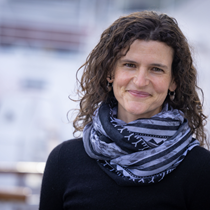Our visit today was perfectly timed after a visit to Viking ruins yesterday. At Brattahlid, we explored reconstructions of a Viking longhouse and a tiny church. The buildings were raised by archaeological experts in the year 2000, and a visit to these places helped to stir our imaginations and make us even more curious about what life would have been like 1,000 years ago.
The longhouse was built of sod walls and roof, and the inside was lined with wood paneling. A stone floor formed the base, but low, wide wooden platforms on either side formed the main living area, where people would sleep, eat, and work on indoor tasks. There was a beautiful loom at the far end to make use of the sheep’s wool. The central fireplace was a key characteristic of Viking homes, and it was beautifully built here.
Just 50 meters away, enclosed in a low sod fence, we entered a tiny sod church. The story goes that the founder of this settlement, Eric the Red, was a lifelong follower of the Norse belief system, but it was a different story for his son, Leif. Leif went to Norway and became very interested in Christianity. When he returned to Greenland he brought some priests with him, and, according to the Sagas, Leif’s mother (Eric’s wife) became a Christian and a tiny church was built for her. Although the reconstruction is up on a hill, the ruins of the original church, called Thjodhild’s church in her honor, sit just meters away from the small modern church still used by this community.
Some of us wandered the town and others climbed the rocks to get a better view. The combination of horses, streams, ruins, and reconstructions within a small community made for a picturesque scene.
We spent the afternoon at sea with presentations from National Geographic photographer Karen Kasmauski and naturalist Carl Erik Kilander. By night, we danced and sang along with our brilliant in-house band, the Spice Boys. We are bound for Nuuk, the capital of Greenland. Onward!







